

"Octopath Traveler": Beautiful JRPG that lacks a little spice
"Octopath Traveler" is not just for JRPG fans. Exceptional aesthetics, a challenging battle system, eight different classes with their own stories and yet the game is not entirely convincing. The Switch is the reason why I didn't give up straight away despite its shortcomings.
I'm beginning to wonder whether games for the Switch should be rated differently. Thanks to its portability, the console always manages to bring games to my attention that I would never have touched on the sofa. Octopath Traveler is no exception. The Japanese role-playing game may have caught my eye earlier due to its unusual 2D graphic style, but due to time constraints and the fact that JRPGs are not necessarily my cup of tea, it would probably still have fallen through my cracks. So instead of deleting Nintendo's email with the corresponding code, I install a game that is supposed to be over 60 hours long, despite knowing better.
The agony of choice that isn't really a choice
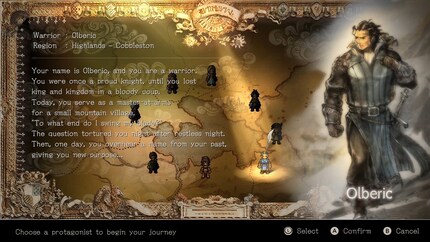
In "Octopath Traveler", the first thing you have to do is choose one of eight characters. Instead of choosing from the usual suspects such as warrior, mage and rogue - ok, strictly speaking there are those too - you can choose from merchant, dancer, apothecary or scholar. Each character has their own story, which is usually told through flashbacks, exposition and active gameplay. This ensures that the different classes feel much more defined than in games, where you get no more information than on the back of the latest fantasy bestseller.
At first, I found it really difficult to decide which of the eight characters to choose. However, a little Kevin birdie (who had already played the demo) whispered to me that you will gradually pick up all the unchosen characters in the game anyway. As you can only have a maximum of four characters in your active party, you still have to keep deciding who to take with you on the next adventure. Only your main character cannot be swapped. Unless you don't like them at all, the initial choice doesn't matter much.
Linear quests without big surprises
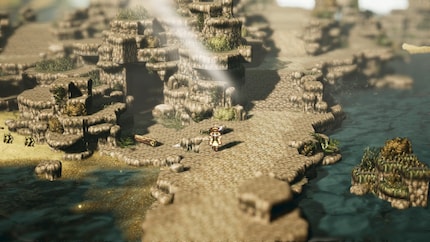
I've opted for the huntress, who is accompanied by a giant pussycat called Linde. On the overview map, you can see right from the start where you can recruit your companions. The order in which you visit them is up to you. As soon as you pick up a new member, you start the first chapter of their story. Theoretically, you could then start the second chapter straight away, but as the areas are levelled, you will be too weak for this at first. So ideally, you should first complete your colourful company before tackling the subsequent chapters.
The stories of the eight characters are almost all typical fairy tales. In other words, they offer few surprises, are very clichéd and always have some kind of moral attached to them. None of the stories particularly grabbed me, although important scenes are set to music and the narrators do a good job (either in English or Japanese). They are exciting enough to keep me listening, but once a chapter was finished, I didn't feel the urge to follow the stories immediately. However, they are warmly told and manage to fill the characters with life and explain their classes in a credible way. Some of them also touch on sensitive topics, not always with the necessary sensitivity, but very elegantly written.
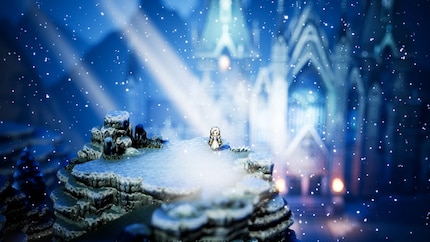
In addition to the eight main quests, you will be given tonnes of side quests. You solve these by utilising the different skills of your heroes. Cyrus, the scholar, can eavesdrop on people to find hidden treasures or clues. Therion is a thief, his ability is self-explanatory. Tressa, on the other hand, is a merchant and only she can buy things from secondary characters. Many of the abilities, such as stealing, have varying chances of success. If you fail with your action, your reputation drops and you can no longer interact with NPCs. The local innkeeper can restore your reputation for a small fee.
Unfortunately, there is little variety on your journeys. The paths are completely linear and most of the time you'll just walk from one signpost to the next. Every now and then you can branch off to loot a crate. Encounters with enemies are triggered at regular intervals so that you always have something to do and don't get too far into the wrong places. If the constant battles get on your nerves, you can equip a skill that halves such encounters. However, this also reduces the experience you gain. The different areas are not too varied and there is not much to discover. You usually run straight from one task to the next.
Tactical battles
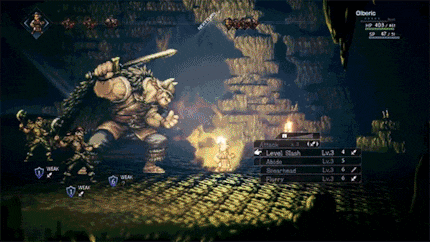
Apart from questing, you spend most of your time fighting all kinds of fantasy creatures or villains. During battles, the camera zooms in on the action. At first I wondered why my characters were tiny compared to the enemies - bosses are easily five times as big. Typical Japanese, isn't it? But I quickly learnt to appreciate this design decision. The imaginative monsters and especially the stylishly staged bosses really come into their own this way.
The combat is turn-based. You can either attack with your weapons or use skills. The latter costs FB, the equivalent of mana. You also receive an additional BP point with each round. You can use these to boost your attacks or abilities. Single attacks such as spells become stronger, while the use of weapons is triggered several times. This is particularly useful if you want to break through an opponent's shield. All opponents have certain weaknesses. You won't know these the first time you encounter them and you will only find them out through trial and error. The shield can be broken by exploiting these weaknesses. If the shield is destroyed, the opponents are stunned for a while and your attacks do more damage.
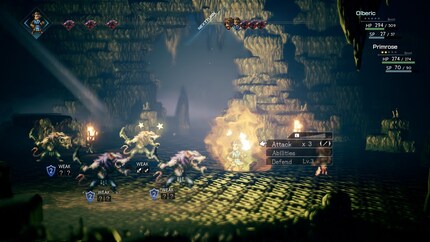
Fights against normal enemies at your level are not very challenging. It's a different story with the many boss fights. In my most tedious fight so far, I had to traipse around with my squad for several hours to trigger encounters. I grinded for hours and increased my level by around seven levels. Only then was I able to beat the boss with great difficulty and by using practically all the items I had collected. Apart from that, "Octopath Traveler" is fortunately not one of those typical Japanese grind RPGs.
Your characters receive experience points as they level up, which you can use to unlock active and passive skills. As there are only a handful of such skills per class, they have an even greater impact.
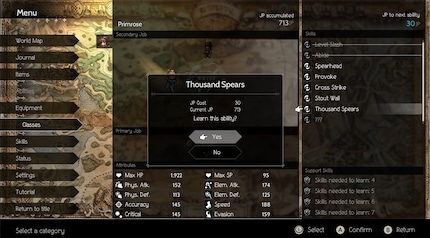
In the beginning, I thought that the different classes were relatively easy to categorise. That's why I travelled with the standard line-up for a long time: warrior, healer, support and mage. However, as I unlocked new skills, more and more tactical options opened up. Some characters rely on teamwork, others are better at looking after themselves. As you have to have the person in question in your team in the main quests, you are forced to play with all the characters. This way you level them up at the same time and learn to appreciate their abilities. However, if you only take them along for their quests, as I did, they will lag behind your main squad in terms of level. Then you'll have to grind a bit if you want them to be more than just extras in battle.
The characters can also be supplied with all kinds of equipment. Unfortunately, you won't see any of this in the game, only the stats increase. So the joy of new weapons and armour is limited.
Cute graphics and atmospheric sound
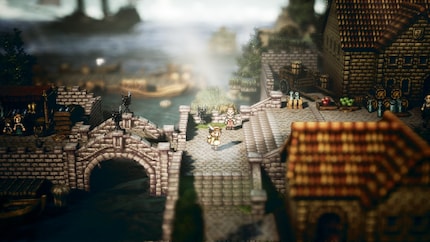
The trailers didn't promise too much. "Octopath Traveler" looks good enough to eat, even up close. The style is reminiscent of classics like "The Legend of Zelda". There have been quite a few of these in recent years. However, "Octopath Traveler" clearly stands out from the competition. The game combines simplified pixel design with modern graphic features. Atmospheric lighting effects, fir trees swaying in the wind and, of course, extreme depth of field are just some of the visual tricks used by developer Square Enix or Acquire to bring the world to life in an impressive way. The manufacturers call it "HD-2D".
The background music is on a par with the graphics. It varies greatly from level to level and is wonderfully Japanese with lots of piano and string instruments. Only in the often extremely long boss battles can the sound become repetitive.
Conclusion: An eternal up and down
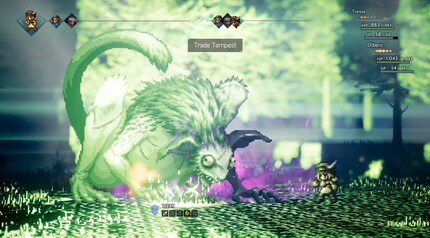
My 30 hours of playing time so far have been a constant up and down experience. Sometimes a chapter was a bit more exciting, then there was a lull and wandering around in the linear world again. This was followed by another interesting fight with new enemies, then another tedious quest. The playing time clearly shows that the game was always able to motivate me to continue. But I regularly had to give myself a jolt to pick up the Switch again. The fact that I did it anyway was often due to the accessibility of the mobile console.
"Octopath Traveler" impresses with its presentation, but the gameplay lacks the decisive flavour. Why is there so little to discover in the world? Why are the paths so linear? Many of the side quests also feel like hard work. You always have to go to the inn first to exchange a character that you need because of their ability. Found the purple box? Get the rogue. Someone has a secret? Get a scholar. Someone is selling a certain item? Get a merchant. Depending on how fully you want to play the game, you can rotate your entire party in each new location to check out all the NPCs. That's definitely too tedious for me.
However, I will remain loyal to "Octopath Traveler" for a while yet. Not least because of the boss battles, which are sensationally illustrated and require tactical skill. However, I probably won't be able to suppress the creeping feeling of boredom until the end. But even without seeing the credits, it's worth giving "Octopath Traveler" a chance.
As a child, I wasn't allowed to have any consoles. It was only with the arrival of the family's 486 PC that the magical world of gaming opened up to me. Today, I'm overcompensating accordingly. Only a lack of time and money prevents me from trying out every game there is and decorating my shelf with rare retro consoles.